page 2
(The Study of Threes)
http://threesology.org
Here's an Hypothesis attempting to construct a premise for understanding the pristine influence for the "Threes":
We are environmentally influenced to be genetically predisposed to:
- Conceptualize many of our ideas
- Perform many of our activities
- Grow physiologically
...along a 1 ~ 2 ~ 3 maturational development sequence.
In an attempt to understand what may have influenced such circumstances, I have developed an idea which may explain why, and what, if any additional conditions we should be concerned with for future events. Since much of the following involves how the Sun has affected changes on the Earth over billions of years, let us take a look at an abbreviated short review of how humanity's perception of the Earth in relation to the Sun has changed:
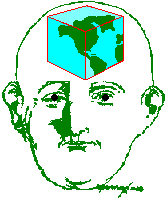 Flat Earth View |
 Round Earth View |
 Triaxial Earth View |
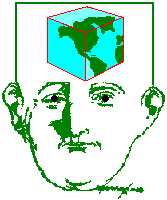 Block Head |
 Dome Head |
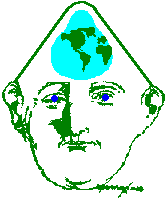 Cone Head |
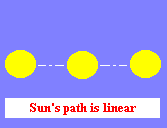 |
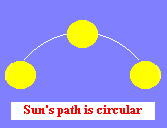 |
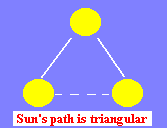 |
The head image was adapted from the website of Phil Lawson & Robert Lindstrom whose conceptual drawings are by Geoffrey Moss.
http://www.sphericity.com/WB/WBa4c32.html
3 points to consider about the above three Earth shapes:
While some observers might want to suggest that a flat Earth does not necessarily imply a cube-shaped Earth, the idea of flat is nonetheless pointed out, along with the reference with respect to the primitive notion that the Sun's path went "across" the sky, giving the impression of a linear-like travel.
Some observers might want to suggest that the usage of half-dome portrayals of the Earth and sky in early artwork does not necessarily imply a circle or spheroid, the idea of a circle-like image is nonetheless pointed out, along with a circular-like passage of the Sun's travel "over" the sky.
Some observers will point out that the idea of a triaxial ellipsoid (pear-like) shape to the Earth is a technical point, while others will find it to be a common-place notion. However, the idea of a triangular path of the Sun's (and Moon's) ascent and descent may not be so widely known nor placed into a perspective of how such can affect biological development in ways other than merely Circadian rhythms.
...The earth's rotational period and the accompanying variations in tides, temperature, and insulation, are among the most universal environmental periodicities to which living systems must adapt. Most theories of planetary evolution place the earth and moon in close proximity and give the earth a much shortened day length at some distant time. By extrapolation using present-day values for tidal friction, the earth and moon can be reckoned to have been in close proximity at some time less than three aeons ago. Under those circumstances the solar day would have been less than 10 hr, possibly as short as 4-5 hr, and punctuated by boiling and condensing tides of great amplitude. The geological record of such a violent event in the earth's history should be clear and serves as a boundary condition for the time of occurrence. The rapid rotation of the primitive earth and the subsequent slowing of rotation rate due to tidal friction in the earth-moon system present a problem in the evolution of an oscillator generating the biological clock. If a short period clock became fixed in the chemistry of early life forms prior to significant retardation of the rotation rate of the earth, then any subsequent rapid slowing of the earth's rotation would have made continuous adaptation of the clock difficult. If the clock evolved via saltatory increases in period, then this primitive oscillator must underlie the modern Circadian clock and vestiges of the primitive clock period may be expressed in ultradian rhythms and are mutants of the modern clock. Alternatively, if slowing in the earth's rotation commenced soon after accretion of the planets some 4-5 billion years before the present (BYBP), then somewhat less serious problems in tuning of the oscillator period to the variation in day length from 16-18 hr in the Precambrian to the present 24 hr period need to be explained. In either case the limits of entrainment as they are presently understood would have been exceeded. Robert R. Klevecz http://www.talandic.com/pubs/vestige.html |
To within the limit of accuracy of a carpenter's tape measure, the Flat Earth Model gives as good predictions as that of the spherical trigonometry of a Round Ball Model or the Triaxial Ellipsoid trigonometry. The Triaxial Ellipsoid Model is more accurate that the Spherical Ball Model which is more accurate than the Flat Earth Model. None of these models, constructed by scientists, represent the "TRUE" shape of the Earth. Which Model you use depends upon the amount of accuracy needed in your measurement.
http://www.ac.wwu.edu/~vawter/PhysicsNet/Topics/ModelsInScience/ModelsInScience.html
In thinking about how life began on Earth and why one of its recurring basic components (DNA) has a triplet codon system, it is of some value for us to consider the possibility that there may have been a three-patterned influence that existed during the moment when DNA was being developed Billions of years ago (that may or may not have had a singular origin itself). There may have been either an existing three-patterned circumstance or a singular circumstance which evolves along a sequence that we can describe with an enumerated label such as the "3". Do we simply say that the triplet codon system is due to the third position of the Earth from the Sun and excuse ourselves from further inquiry just as a religious person might do by suggesting the triplet codon is due to some supposed presence of a Trinity? Or do we search elsewhere? The following idea is an attempt to search for some other (testable) plausibility:
3½ to 4 (or 5) billion years ago, the building blocks of life were subjected to an Earth that was spinning much faster than it is today. Instead of our present (approximate) 24 hour day, the early Earth had a daily rate somewhere in the range of from a few seconds to about an hour or so (depending on what mathematical model you use)... though I have only found a few references to the rates of 8 or 14 hours.
By browsing the internet, here are a few examples of different mathematical references to considerations of how fast the Earth is slowing and hence, would speed up if we were going backwards in time:
- 0.000015 seconds per day per year at present
- 0.000020 seconds per day per year in the past
- .00002 seconds per day per year
- .00002 seconds per year
- .0002 seconds per day per year
- .0015 seconds every second
- .0016 seconds per century (1.6 milliseconds)
- .0017 msec per day per century (1.7 milliseconds)
- .002 seconds per day
- .002 seconds per day per year
- .002 seconds per century (2 milliseconds)
- .0053 seconds per year
- .005 seconds per century (5 milliseconds)
- 1.4 milliseconds per century
- 1.48 milliseconds per century
- 1.5 milliseconds per day (0.0015)
- 1.5 milliseconds per century
- 1.5 - 2 milliseconds per century
- 1.7 milliseconds per year
- 2.3 milliseconds per century
- 2.5 milliseconds per century
- 3 milliseconds per century
- 1 second every 500 days
- 1 second every ten years
- 1 second every 625 years
- 1 second every 50,000 years
- 2.2 seconds per 100,000 years
- 16 seconds every million years
- 22 seconds every million years
- 30 seconds per century
- 3 hours over 2000 years
- 20 days per year every 200 million years
- etc...
{milliseconds = msec}
Here is another example of rotation rate changes based on the reports of "counting of daily growth rings on corals, but some similar (and supportive) information comes from looking at things like brachiopods, bryozoans and pelecypods (clams)." (Like counting the rings of trees, fossilized remains of several types of life forms exhibit yearly patterns of growth with respect to the Sun and Moon.)
| Geologic time period | Millions of years (mybp) |
Days per year | Hours per day | |
| Present day | 0 | 365 days | 24 | |
| End Cretaceous "Jurassic Park" Permo-Triassic Middle Devonian Early Ordovician Earliest Cambrian Late Precambrian |
65 180 245 370 500 600 900 |
371 days 381 days 386 days 398 days 412 days 424 days 487 days |
23.75 23.3 23.125 22.625 22.04 21.54 18.91 |
(23.33333333) (21.54166666) (18.91666666) |
{mybp = millions of years before present}
Table data adapted from:
http://www.lhs.berkeley.edu/PASS/v7SlowingEarthRotation.html
Also see information on:
http://www.threesology.org/rotation-rate-1.php
In the above table I have included the information colored with a green background using the following generalized math formula:
365 (days) ÷ by 24 (hours) = 15.20833333 (days per hour)
365 X 24 = 8,760 (24 hour days per a 365 day year)
371 - 365 = (6 days difference)
6 X 15.20833333 = 91.24999998
8760 - 91.24999998 = 8668.750001
8668.75001 ÷ 365 = 23.75 hours per day
You need only substitute the numerical values in blue, with respect to the information for each time period being calculated.
To give us some idea of how fast the Earth was spinning some 5 billion years ago, let us use some of the information from the above data to arrive at a generalized notion of how much the length of a day increases. By subtracting the second from the last number of the 2nd column from the last number of the same column, we arrive at 300 mybp (900 - 600 = 300). By subtracting the second to the last number of the third column from the last number in the same column, we arrive at 63 days (487 - 424 = 63).
Hence, for our generalized equation, let us say that there is a difference of 63 days every 300 million years. Assuming that everything remains constant over 5 billion years (even though it doesn't): Our generalized equation discovers that there are 16.6666666 separate 300 million time periods in 5 billion years. (I divided 5 billion by 300 million.) By multiplying 16.6666666 by 63 (days), we find that the length of days per year 5 billion years ago was 1,049.999999. By dividing this by 365 (days), we encounter a difference of 2.876712326. In other words, the length of a single day 5 billion years ago was almost 3 times faster, or about 8 hours long, or from another perspective, the Earth was spinning at about 3,000 miles per hour at the equator (in comparison to the present approximate rate of 1,000 miles per hour).
Here is the simplified equation:
900 - 600 = 300
487 - 424 = 63
5,000,000,000 ÷ 300 = 16.6666666
16.6666666 X 63 = 1,049.999999
1,049.999999 ÷ 365 = 2.876712326
24 ÷ 2.876712326 = 8.34285715
| Geologic time period | Billions of years (bybp) |
Days per year | Hours per day | |
| Primordial Soup era | 5 | 1,049 | 8.3 | (8.34285715) |
{bybp = billions of years before present}
Interestingly, if we use the above table information and apply it to the first generalized equation, we get a daily rotation rate of 4.499999972 hours for 5 billion years ago!
Until the 1960s, the only evidence supporting the rotational slowing came from astronomical observations. Then paleontologist John Wells found that certain long-dead corals contain the annual rings within their fossilized skeletons a record of the passage of days and years. Within the rings are fine laminations that record daily deposits of calcium carbonate by the coral polyp within the skeleton. Careful examination of fossil corals from previous geological periods spanning millions of years reveals that the average number of laminations within each set of rings increases as one searches further and further back into time. For example, in the Devonian period, some 370 million years ago, fossil corals contain an average of 400 laminations per ring. This indicates that the corals lived through a year of approximately 400 days, with each day only about 22 hours long.
Paleontological evidence also shows the lunar recession. Consider the chambered nautilus, a cephalopod related to octopuses and squids. Once nautiluses were a mighty group, 10,000 species strong. But like so many other tribes, most have disappeared. Today only a scant five species remain. The nautilus lives within a shell and, as it grows, it secretes a new chamber into which it moves. The animal then seals off the old chamber with a septum, or wall. Between the septa of present-day nautiluses is an average of 30 fine laminations, which suggest that each lamination represents one day and the secretion of the septa is tied to the 30-day lunar month.
Fossil nautiloids show an almost linear decrease in the number of laminations per chamber as one examines progressively older specimens. The youngest fossil nautiloids have about 25 lamina per chamber. In the Ordovician period some 420 million years ago, each chamber contains only nine or ten laminations. The lunar cycle in the Ordovician must have been only nine or ten days. From Kepler's laws of planetary motion, astronomers can deduce the Moon's distance in the past from its present distance, present orbital period, and past orbital period. A 10-day month means that the Ordovician nautiloids saw a gigantic Moon at a distance of about 100,000 miles -- just over 40 percent of its present distance. Their day would have been about 21 hours long at a rotational slowing rate of 0.00002 seconds per year, and each year would have had 417 days, assuming no change in Earth's orbit around the Sun.
by Edward J Greding, Jr.
http://www.muq.org/~cynbe/facts/monthgrowth.html
A creationist perspective of the slowing rate of the Earth's rotation
relative to lunar events providing an "Intelligent Design Model" based upon the
notion of a deliberately ordered "seven-squared" formula may be found at
this site:
http://www.creation-answers.com/time.htm
Giving the author the benefit of the doubt for his calculations, we must now ask why this same deliberately ordered "seven-squared" formula is not uniquely represented in physics, genetics, nor language? In other words, why is there not 7 families of fundamental particles instead of three? Why not a 7 codon system in DNA instead of a triplet codon system, nor 7 primordial Germ layers instead of 3, nor 7 fundamental domains of life instead of 3 domains? Why is there not a 7-modal system in language instead of a tri-modal structure? It is thus necessary to consider that the so-called deliberately designed "seven-squared" formula has not been a primary "intelligently designed" influence on biological development nor influential in so many different areas of modern intellectual contemplation.
Here's another example of calculating the length of a day for millions of years ago:
We should expect the Moon to be currently retreating from the Earth because of the tides it raises on the Earth. There is dissipation in the system and so although the orbital energy of the system is not conserved, the angular momentum is still a constant. However, the angular momentum is composed of the orbital angular momentum of the Moon *PLUS* the rotational angular momentum of the Earth. Since the total is conserved, the retreat of the Moon from the Earth (i.e. the increase in the Moon's orbital angular momentum) has to be combined with a slowing down of the Earth's rotation (i.e. a decrease in the Earth's spin angular momentum).
A simple dynamical model relates the orbital radius,
a, of the Moon to the spin period, T, of the Earth. The relationship is: 1 = 0.832
* Sqrt(a/60.4) + 0.168 * (24/T)
where a is in
Earth radii and T, is in hours. At the moment a
= 60.4 and T = 24 hours.
| Time (Millions of years ago) | a (R_Earth): Earth Radii | T (hours) |
| -100 | 59.7 | 23.3 |
| -200 | 59.0 | 22.7 |
| -300 | 58.3 | 22.1 |
| -400 | 57.6 | 21.5 |
| -500 | 56.9 | 20.9 |
http://www.sciencenet.org.uk/database/Physics/0104/p01478d.html
Other views involving the slowing of Earth's rotation rate: (All links may not be viable since the above information was last compiled in May of 2005.)
--- How Good Are Those Young-Earth Arguments? ---
By Dave E. Matson
http://www.talkorigins.org/faqs/hovind/howgood-yea2.html
--- The Slowing Spin of the Earth ---
http://www.creation-answers.com/slowing.htm
--- Historical Values of Delta T ---
http://sunearth.gsfc.nasa.gov/eclipse/SEhelp/deltaT2.html
--- The sands of time and tidal friction ---
http://www.astro.uni-bonn.de/~pbrosche/aa/acta/vol03/acta03_100.html
--- Tides ---
http://www.astronomynotes.com/gravappl/s10.htm
--- Tidal Slowdown, Coral Growth, and the Age of the Earth ---
http://www.ibri.org/Tracts/tidaltct.htm
--- Brain "busters"- angular momentum, moment of inertia, etc. ---
http://hydro4.sci.fau.edu/~rjordan/busters_6/answers_6.htm
--- Earth-Moon Interaction ---
http://burro.astr.cwru.edu/Academics/Astr221/SolarSys/earthmoon.html
A view on early Greek Astronomy:
--- Inventing the Solar System: Early Greek Scientists Struggle to Explain How the Heavens Move ---
http://www.perseus.tufts.edu/GreekScience/Students/Ellen/EarlyGkAstronomy.html
--- Nasa Spacelinks- 89-06-13 --- 6/12/89: Chinese Artifact Provides Clue to Earth's Rotation
Some interesting calendar facts:
--- History and Info. Timeline ---
http://webexhibits.org/calendars/timeline.html
Folklore about the Sun:
--- Solar Folklore ---
http://solar-center.stanford.edu/folklore/folklore.html
Herb O. Buckland
herbobuckland@hotmail.com